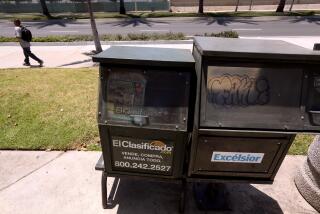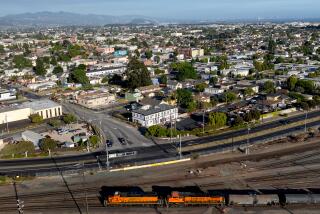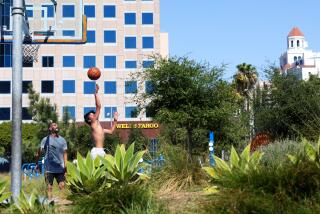From Polo to Parades to Pageants, Palisadian-Post Promotes It All
It promotes everything from the year’s first baby to the town’s first lady, and treats seasonal parades and debutante balls as important civic news. In between, it covers everything: no event too small, no story too big, and no person too rich or too famous.
Welcome to the Palisadian-Post. Every week since 1928, the paper, in various forms, has been slapping against the doors and jamming the mailboxes of some of the richest homes in Los Angeles, telling all what meeting, which contest and what mini-mall are planned for the community’s future. It not only reports all the news in town, it sometimes makes the news.
When one activist came up with an idea for a downtown bus shuttle, it was relayed via letter to editors at the Post, who presented the proposal to the community in an article, which mushroomed into a debate that became a regular front page story. The shuttle recently was approved by a Los Angeles City Council committee, and no doubt will be examined and reviewed in future articles of the Palisadian-Post.
Last week, the Post became the news. It celebrated the 60th anniversary of continuous publication with a party at its downtown office. First known as the Palisadian, and later merged with the Pacific Palisades Post, the paper is to the community what a game-day program is to the Dodgers: upbeat, colorful and, to the town’s true believers, largely essential.
“It’s the perfect neighborhood newspaper, serving as an outlet for anybody who has something to say,” said Peter Fleming, a town council member. “I don’t think it could be any better. They give tribute to the people in the community.”
Focus on Westside
Much like the residents in the Palisades, the paper views the Westside area as clearly distinct from the rest of Los Angeles, a place to be sheltered from the encroaching metropolis. Neighboring communities, such as Santa Monica and Malibu, are left to deal with their own problems and be covered by their own newspapers.
The paper’s philosophy is simple. “We cover anything that relates to the Palisades,” said Managing Editor/Society Editor Juliet Schoen. “We’re a forum for the community, and we will promote things that are important to the community.”
That can include regular coverage of Occidental Petroleum’s plan to drill in the Palisades, or giving prominent display to a local women’s club meeting. Ditto for the sports pages, which blanket the little leagues to the big leagues, as long as they involve current or former Palisadians. Local charities, fund-raisers and weddings are standard fare in each Thursday’s paper.
‘Groups Love Us’
“We believe that all these people who are raising money for charities should be recognized,” Schoen said. “Who else is going to put in a picture of the Palisades Women’s Club Boutique? We’re very happy to let people know that they can come to us when they want to get something in the paper. These groups love us because nobody else recognizes them.
“Society news is important here because we have a wide variety of social groups still operating in the Palisades. If somebody gives us their wedding announcement, we use every bit of information that they give us. If they tell us that their mother-in-law wore a purple garter at the ceremony, we’ll put it in.”
But the news in the Palisades recently has been decidedly downbeat. Pacific Palisades High School senior Teak Dyer was killed at a town office complex in July and a patrol officer for a local security firm has been charged. The killing shocked the quiet bedroom community of 30,000, launching a shrill public debate over how parents ought to deal with local youths.
The Post, with four full-time reporters and a photographer, including Schoen, has doggedly pursued the story, as well as recent controversies over a proposed 24-hour service station, preferential parking and huge residential developments that have been popping up in the hillsides and canyons. As with most community newspapers, the editorial staff does everything from taking pictures, to laying out pages, to writing headlines (“Sands sign still stands,” “Power polo pops into play,” and “Deb daughters do it again,” topped a recent front page.)
More Hard News
“Covering the news here can be very intense because people tend to get upset and vocal about things,” said Cynthia Frazier, associate editor. “Everybody in the community comes to us when something like that happens, and we feel that we have to respond. We’ve gotten a lot more hard-news oriented as the community has grown and been faced with a lot of the problems that go along with that.”
The Post is one of a chain of eight newspapers owned by the Small Newspaper Group Inc. of Illinois, and it is the smallest, with a paid circulation of about 4,100. The Smalls, who purchased the paper in 1981, say they have no intention of changing the paper, other than to try to get more subscribers within the community.
Tom Small, president of the newspaper group, said the newspaper is profitable, but he declined to give figures. He said nearly 70% of the money generated at the paper is made through the paper’s outside printing business, which includes newsletters, brochures, business cards and other newspapers. The Brentwood Post, a virtual reprint of the Palisadian Post with added Brentwood news, folded several years ago because subscribers and retail advertisers in the area wouldn’t support it, he said.
“I’m a bit disappointed that more people in the community don’t subscribe to the paper, but I see the newspaper as going pretty much unchanged,” Small said in a telephone interview from his home in Chicago. “The paper has a fine journalistic tradition, and although we would like to sell more papers in Malibu and Santa Monica, that would require a larger investment than we are willing to make right now.”
Publisher Roberta Donohue, who rose through the paper’s ranks during the last 15 years, starting as a typesetter before assuming her present position in December, said the paper’s goal is to reach a paid circulation of 5,000 and expand the editorial staff. Donohue and others expressed surprise that in a community where the median home price exceeds $660,000, more people don’t pay the $12 yearly subscription to find out what’s going on in town.
‘Possessive’ About Paper
“The newspaper has played a big part in the town’s history,” said Donohue, who was born and raised in the Palisades. “The people who take the paper feel possessive about it, like they have their very own little newspaper. It’s a family community and the only way people here know what’s going on every day is by reading us.”
Schoen, “the fire which ignites the Post each week,” according to a in-house newspaper ad, said that a good indication of the paper’s stance in the community could be gauged by the paper’s recent experiment with a new printing press.
“We came out late two weeks in a row and the phones were ringing off the hook,” said Schoen, a veteran of Fairchild Publications in New York City. “Everybody was saying, ‘Where’s my paper, where’s my Post?’ They can’t wait for us to come out each week. The paper is what keeps things going here.”
More to Read
Sign up for Essential California
The most important California stories and recommendations in your inbox every morning.
You may occasionally receive promotional content from the Los Angeles Times.










